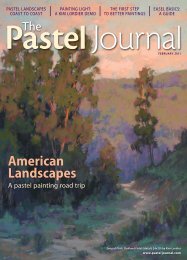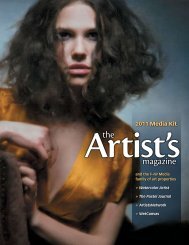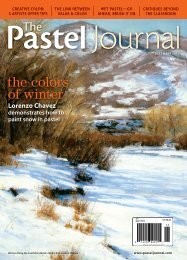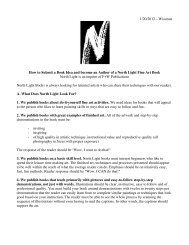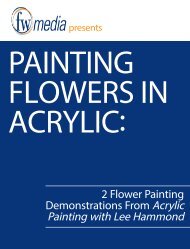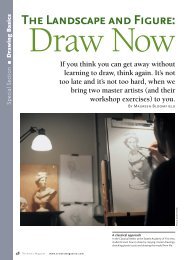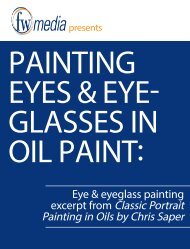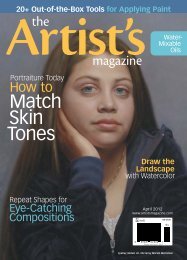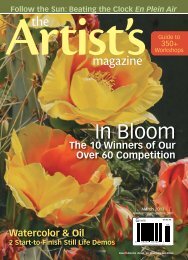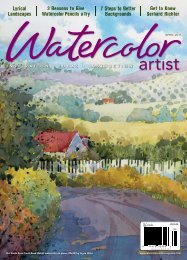The Artist's Magazine, December 2011 - Artist's Network
The Artist's Magazine, December 2011 - Artist's Network
The Artist's Magazine, December 2011 - Artist's Network
Create successful ePaper yourself
Turn your PDF publications into a flip-book with our unique Google optimized e-Paper software.
01 02 03 04 FnL1 Qy1BDDAwOTI4MTAyMzA2NwA=<br />
JUYrVyBQdWJsaWNhdGlvbnMsIEluYyAo<br />
SW9sYSBkaXZpc2lvbikPR3JlZ29yeSBL<br />
cnVlZ2VyAE0R538EMTAuNAI4MAExBVVQ<br />
04 0120<br />
Simple Secret of Composition: the Vertical Line<br />
All About<br />
Alkyds<br />
<strong>The</strong> 30<br />
Winners<br />
of the 28th Annual<br />
Art Competition<br />
Plan Ahead<br />
170+ Workshops<br />
Here & Abroad<br />
Master Spatial<br />
Relationships by<br />
Drawing Triangles<br />
<strong>December</strong> <strong>2011</strong><br />
www.artistsmagazine.com<br />
US $5.99<br />
12<br />
0 09281 02306 7<br />
Display until <strong>December</strong> 5, <strong>2011</strong><br />
Portrait/Figure category 1st place winner Amelie (detail; oil, 19x12) by Thomas Reis
from Mastering Composition (North Light Books, 2008) by Ian Roberts<br />
find the vertical<br />
For a fully enlivened<br />
picture plane, engage<br />
both horizontal and<br />
vertical lines of force.<br />
BY IAN ROBERTS<br />
60 www.artistsmagazine.com
EVERY ACTIVITY HAS ITS ARENA. In painting,<br />
the arena isn’t the studio but the canvas—the<br />
very specific horizontal and vertical surface of<br />
your picture plane.<br />
With your first mark on the canvas,<br />
you create a dynamic tension. Each additional<br />
mark you make adds more complexity.<br />
Obviously, the goal isn’t to create complexity—<br />
that’s a by-product you have to deal with. Your<br />
goal is to orchestrate engagement. <strong>The</strong> reason<br />
we still look at great paintings, ones that<br />
people have admired for 200 years or more, is<br />
precisely this. <strong>The</strong> arena of their picture plane<br />
holds, engages and fascinates us.<br />
LEFT: <strong>The</strong> various elements of<br />
Laura’s Carpet (oil, 30x30) were<br />
consciously arranged to draw the<br />
eye to the center of interest, which<br />
appears at the intersection of horizontal<br />
and vertical lines of force.<br />
Armed With an Armature<br />
How do the creators of great paintings accomplish<br />
this feat <strong>The</strong>y use, of course, all the tools<br />
of good painting—strong value masses, subtle<br />
color intensities and harmonies, edge quality,<br />
great drawing. But one principle underlies all<br />
these tools: <strong>The</strong> artists make full use of their<br />
arenas. <strong>The</strong> image on the canvas fully exploits<br />
the dynamic of the picture plane.<br />
A study of older paintings<br />
reveals a geometry underlying<br />
the composition. Sometimes<br />
this is mathematically derived,<br />
but often it’s schematic. This<br />
geometry can be called the<br />
armature of the composition—the lines of force<br />
in the structure of the painting that engage all<br />
the parts of the canvas.<br />
<strong>The</strong> armature is the foundation upon<br />
which everything is built. <strong>The</strong><br />
term comes from the wire support<br />
to which sculptors apply their clay.<br />
It serves two functions: supporting<br />
the clay and establishing the<br />
line of the figure. In painting, the<br />
armature plays the fundamental<br />
role of describing the horizontal<br />
and vertical lines of force that<br />
enliven your whole canvas, left<br />
to right and top to bottom (see<br />
Foundational Armature, at right).<br />
Foundational Armature<br />
Dramatic value masses make a strong statement<br />
in Morning Market (below; oil, 8x10), but it’s the<br />
underlying armature (above) upon which those<br />
masses hang that enlivens the picture plane with<br />
horizontal and vertical lines of force.<br />
Half-Armed Landscape<br />
Let’s look at the genre of landscape<br />
by way of example. Any<br />
landscape has a horizontal engaging<br />
the left and right sides of the<br />
picture plane. It’s the horizon. It’s<br />
always there. Even if the horizon<br />
is only implied, we feel it.<br />
<strong>December</strong> <strong>2011</strong><br />
61
Vertical By Design<br />
<strong>The</strong> vertical usually isn’t one long line from top<br />
to bottom but the linking of several elements,<br />
like the clouds, trees and road in Road to Sablet<br />
(left; oil, 36x36). Sometimes you need to impose<br />
the vertical in this way. <strong>The</strong> point to consider is<br />
whether you’re orchestrating the design of your<br />
painting or just cataloguing what’s in front of you.<br />
But what’s engaging the top and the bottom<br />
of the picture plane That’s the really<br />
important question. You want the whole arena<br />
alive—alive by design. From there you can<br />
create emphasis as well as repose to lead the<br />
eye purposefully around the picture. First,<br />
however, you must establish a fully engaged<br />
picture plane.<br />
A landscape with a horizontal line of<br />
clouds and then another horizontal line of hills<br />
and another line of trees and a couple more<br />
lines of fields creates a dynamic interplay with<br />
only the two sides. That landscape doesn’t have<br />
a vertical line of force, and that’s what you<br />
need to find.<br />
Fully Armed Landscape<br />
What do I mean when I say that you need to<br />
find the vertical Because we’re so accustomed<br />
to the horizon, we don’t feel how powerful its<br />
left-right energy is in our paintings, but that<br />
energy is there, and we need the vertical to<br />
counterbalance it.<br />
Finding the vertical means thinking about<br />
design before subject. You want to feel the<br />
energy of both axes before you start to paint.<br />
Usually my students, when first confronted<br />
with this idea, look at slight diagonals—<br />
horizontals on a bit of an angle—and, linking<br />
a couple of those, feel they’ve found a vertical.<br />
I then take them over to one of those diagonals,<br />
say the edge of a field or a road, so that,<br />
as we’re standing on it, that line moves directly<br />
away from us. In other words, that line would<br />
be perpendicular to the horizon on the picture<br />
plane. When I do this, a light goes on for<br />
them: “Oh, I see. You mean a vertical vertical.”<br />
(See Vertical by Design, above.)<br />
Going out with a sketchbook and pencil,<br />
looking for an interplay of the horizontal<br />
and vertical and making small value sketches,<br />
makes the idea more concrete so that it begins<br />
to inform your paintings (see Draw Out the<br />
Composition, opposite page, top). Setting up a<br />
still life with this in mind does the same thing<br />
(see Armatures in Other Genres, opposite<br />
page, bottom).<br />
This doesn’t mean the armature is obvious.<br />
Usually the lines of force are buried behind<br />
the subject matter, but they can be felt, and<br />
they do anchor the composition to the picture<br />
plane.<br />
You can, of course, find terrific paintings<br />
in which the vertical isn’t apparent. This is rare,<br />
62 www.artistsmagazine.com
Draw Out the<br />
Composition<br />
A<br />
You can learn a lot by going out and not painting.<br />
Instead, just draw value studies of compositions.<br />
This frees you to find good design possibilities<br />
around you. You’ll find the exercise informs your<br />
work when you come back to paint.<br />
Notice how the tension and pull of the composition<br />
of sketch A is off to the left. Everything<br />
else supports and leads to that area of interest.<br />
<strong>The</strong> vertical in my sketch, though hidden among<br />
the landscape elements, is clearly visible in the<br />
diagram (B).<br />
B<br />
Armatures in Other Genres<br />
C<br />
D<br />
In still life you’re in control of many<br />
factors—objects, light, background<br />
and so on. You need to make sure you<br />
impose both the horizontal and vertical<br />
to fully animate your picture plane. In the<br />
still life sketch (C), the table provides a<br />
strong horizontal, while the draped cloth<br />
linked to the bowl, jar and jar’s contents<br />
provide the vertical.<br />
Most portraits and standing figures<br />
engage the vertical; the horizontal may<br />
be secondary. In my compositional<br />
sketch of a figure (D), the couch supplies<br />
the horizontal. On the other hand,<br />
a reclining figure would have a strong<br />
horizontal and would need a vertical to<br />
counterbalance it.<br />
<strong>December</strong> <strong>2011</strong><br />
63
though, and I suspect that in most cases some<br />
other design element is playing so strongly that<br />
the vertical becomes unnecessary.<br />
Forearmed With Awareness<br />
<strong>The</strong> inert materials of canvas, paint and<br />
brushes are only brought to life by the quality<br />
of your awareness. Consciously employing a<br />
horizontal and a vertical increases your awareness<br />
of the structure inherent on your canvas,<br />
and by becoming more conscious of the specific<br />
dynamics of your chosen picture plane,<br />
you have more scope for play. That gives you a<br />
new tool with which to engage the viewer with<br />
your work. ■<br />
E<br />
F<br />
IAN ROBERTS is the author of Mastering Composition:<br />
Techniques and Principles to Dramatically Improve<br />
Your Painting (North Light Books, 2007) and Creative<br />
Authenticity: 16 Principles to Clarify and Deepen Your<br />
Artistic Vision (Atelier Saint-Luc Press, 2004). See www.<br />
artistsnetwork.com/tamonlinetoc for information about<br />
both books. Learn about Roberts’s paintings, videos and<br />
workshops in Provence, France, at www.ianroberts.com.<br />
<strong>The</strong> Only Rule<br />
from Mastering Composition (North Light Books, 2008) by Ian Roberts<br />
ABOVE: <strong>The</strong> simple<br />
yet dramatic design<br />
of Green With Red<br />
(oil, 16x20) packs a<br />
lot of power, much<br />
of which comes<br />
from its armature of<br />
strong horizontals<br />
and verticals (right).<br />
Representational art has developed a number of<br />
conventions over the centuries. <strong>The</strong> moment you<br />
call them rules, you can find someone who has<br />
made a successful painting that has ignored that<br />
rule; however, I would say one rule does exist<br />
for representational paintings that hang on the<br />
wall: Keep viewers within the boundaries of your<br />
picture plane.<br />
Too often, lines of contrast—edges between<br />
two shapes—pull the viewer’s attention out of<br />
the arena of a picture plane. Once out, the viewer<br />
is gone and probably not coming back.<br />
<strong>The</strong> density of the line in E (at top) represents<br />
the strength of its visual pull. Lines of pull are<br />
created by value contrasts and color shifts<br />
between color shapes on the canvas. Here the<br />
viewer is out and gone to the right.<br />
In F (above) the density of the horizontal and<br />
vertical lines of the composition pull the eye into<br />
the picture plane. To achieve this in a painting,<br />
you would diminish contrasts that could pull the<br />
viewer out of the edges of the picture plane and<br />
enhance those that would pull the viewer in.<br />
64 www.artistsmagazine.com
Did you enjoy<br />
this article<br />
Order the entire issue, available in print or<br />
digital format, at northlightshop.com.<br />
Get the best<br />
art instruction all year long!<br />
Subscribe to <strong>The</strong> Artist’s<br />
<strong>Magazine</strong> for one year<br />
for $21—a savings of<br />
63% off the newsstand price!<br />
As a Bonus, get another<br />
great art magazine<br />
at a discounted price:<br />
• one year of Watercolor Artist<br />
for just $10 more—a savings of<br />
72% off the newsstand price!<br />
• OR one year of <strong>The</strong> Pastel Journal<br />
for just $16 more—a savings<br />
of 65% off the newsstand price!<br />
Subscribe today at http://<br />
artpubs.artistsmagazine.com.<br />
All media, collage<br />
and illustration<br />
www.artistsmagazine.com<br />
Watercolor, acrylic and<br />
mixed watermedia<br />
www.watercolorartist<br />
magazine.com<br />
Pastel and pastel<br />
mixed media<br />
www.pasteljournal.com



